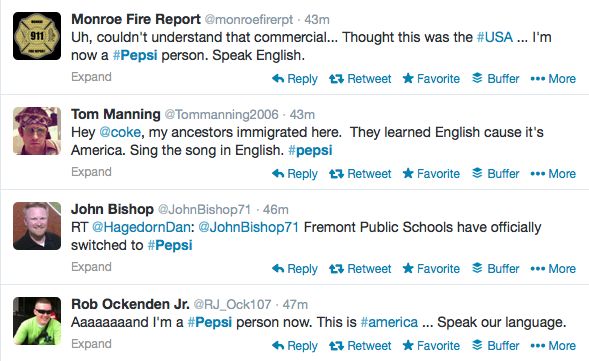Why Coke’s Super Bowl spot was so perfectly wrong and accidentally brilliant
[This article was published originally in 2014. At the time, Coca Cola was facing a social media storm for airing a 30-second spot on the Super Bowl that featured a multicultural cast singing “America the Beautiful.” Sadly, but perhaps unsurprisingly, the spot was quickly retired. So we were quite surprised to see “It’s Beautiful,” in all its original glory, run in the opening commercial break of this year’s Super Bowl (2017). Given the current political climate, with an argument raging between the U.S. executive and judicial branches over the president’s order to halt travel and immigration from seven Muslim-majority countries, and the anger and calls to boycott this spot predictably creates, we consider Coke’s decision brave. Patriotic even.]
Twitter exploded seconds after Coca Cola had the temerity to run a Super Bowl commercial celebrating diversity in the United States. The spot’s soundtrack featured a rendition of America the Beautiful sung by children in English, Spanish … and six other languages.
Oh, horror of horrors.
The spot also showcased a group of Muslim-American girls getting Chinese food from a street vendor, some African-American kids breakdancing and a gay family ice-skating.
Racist and xenophobic comments spewed. Threats of boycott were issued. “This is America, we speak English“ more than a few tweets stated, non-ironically.
Of course, others were outraged by the outrage. More than a few defenders pointed out that diversity has long been Coke’s brand, and that the new spot wasn’t all that different than the much loved I’d Like to Teach the World to Sing commercial from 1971.
Yet, somehow, this was different.
Coke has produced some of the most adorable “can’t we all just get along” advertising over the last few years, and may not have been intentionally courting controversy with #AmericaIsBeautiful. It most certainly cannot be loving the comments which, as of this writing, are still spilling down its Facebook page. I suspect the creative folks at Wieden+Kennedy, the agency that produced the spot, weren’t all that surprised. That firm is famous for exploiting cultural touchstones to gin up engagement. But I bet even they’re taken aback a bit.
Why Did the Coke Spot Spark So Much Anger?
Everybody knows the Super Bowl is not just another football game. It’s a national holiday. Almost sacred. Well, actually, kind of anti-sacred.
I’ve written about this before.
With New Years, once a day of national hangover and regret, now pretty much tamed by actual prison sentences for driving while intoxicated, a space has opened in our culture for a new “inversion” holiday. Like Rome’s Saturnalia and medieval Europe’s Feast of Fools, the Super Bowl has become our day for reversing the social order and celebrating, for a day or a week, depending on your level of fandom, all the things we’re required to control the rest of the year.
Anything intellectual, ecclesiastical or feminized (which of late has become the worst of sins) is lampooned, satirized and aggressively ignored.
The Super Bowl has become a kind of cultural safety valve. A time when resentments are aired, brutality is pedestalized and gluttony is condoned. Apparently, as long as its celebrants agree to go back to work on Monday, and spend their wages on Dodge Rams, Doritos and Maseratis(?) the rest of the year, no controls will be imposed during the celebration.
Could this be why the Coke spot generated such vitriolic spew?
Personally, I loved the spot. Thought it an instant classic. But I don’t think my opinion counts, as I haven’t been invested in a Super Bowl since 1969. (And speaking of Joe Namath and the Super Bowl …)
But to a certain segment of those in the thrall, Coke’s spot apparently was read as an insult; a preachy bit of political correctness injected into the middle of what everyone agreed was supposed to be a breasts-out-bacchanalia, even if GoDaddy disappointed this year.
But Here’s Why Coke’s Spot Was (Perhaps) Accidentally Brilliant
Good advertising is often polarizing. Go down the middle and nobody notices. But take a controversial position and you can gain a rabid following. Even if you drive most prospects away, the ones who remain become fierce brand loyalists.
It’s so good a strategy that Kraft once cooked up a quasi-controversy to promote Miracle Whip.
But Coca Cola is in a different league. The Atlanta-based company holds down the #1 and #2 spots in the soft drink biz, with Coke and Diet Coke. Pepsi’s has been #3 for a while. As Coca Cola has no place to go but down, courting controversy seems, on the surface at least, quite a stupid strategy.
Pepsi returned to the Super Bowl big time the last couple of years after famously pulling out in 2010 to fund its successful/not successful Refresh Challenge. Since then, the company has left no new media stone unturned. Crowdsourced creative, viral videos, Beyonce and Bruno Mars.
Yet, after heaven knows how many gazillion dollars spent, there went Coke, with a more-or-less traditional 30-second spot that drove the racists of America to embrace its rival’s brand … and broadcast their love of Pepsi to the world.

Coke has managed to brand Pepsi as the choice of a reactionary and racist generation. Who knows, that positioning may play domestically for Pepsi. But internationally, it means trouble.
[Update: Thanks to Doug Tonks for the proofreading! If anybody wants to hire a good editor?]